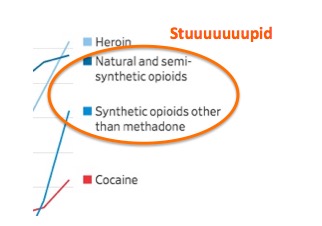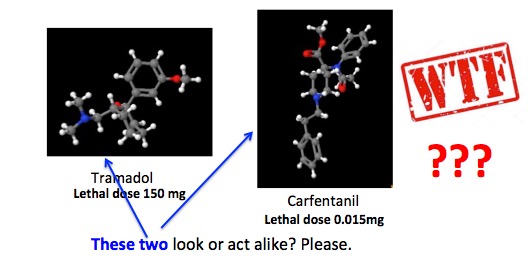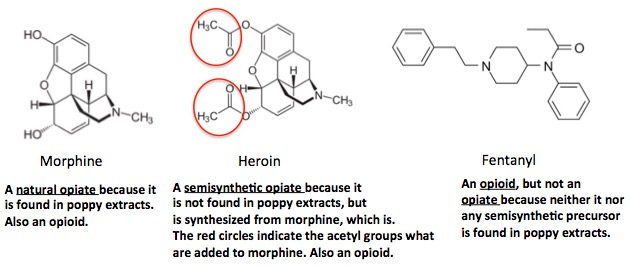As if our government and press haven't screwed up the story of the so-called "opioid crisis" thoroughly enough, why not add some meaningless and confusing terms to the mix so that absolutely no one knows what the hell is going on.
And what better way to do it than to throw around words that are confusing, meaningless and absolutely unnecessary. Virtually every report on this mess, especially those with graphs, will include the term "synthetic opioid" as a category. Modified from today's Wall Street Journal:

Figure 1. The arbitrary division of pain drugs into "natural and semisynthetic opioids" and "synthetic opioids" is a chemical abomination. It implies that there is an innate difference between the two drug groups merely because one of the groups was made in a lab and the other extracted from poppy and then made in a lab. Ridiculous. Like all drugs (chemicals too) the origin of a substance is utterly irrelevant.
What is really meant by "synthetic opioids other than methadone" is pharmaceutical fentanyl as well as illicit fentanyl and its analogs. But as used now, the silliness of subdividing pain drugs into arbitrary and bewildering classes based on how they are made serves only to confuse us more. This will become obvious.
Example: Here are some synthetic opioids as defined today:
What's the harm? Plenty. I have repeatedly criticized Andrew Kolodny, the former president of Physicians for Responsible Opioid Prescribing (PROP), for using numbers to disguise rather than inform. Aside from being scientifically erroneous, the practice of using fuzzy ill-defined categories makes it easier to frame and shape a story rather than to simply give the facts in an accurate manner.
Pardon the chemistry, but there is no other way to show how misleadingly ludicrous these groupings are. According to current convention, the following mess (Figure 2) is what passes for science today. The four following analgesic drugs below have somehow been placed in the same category - synthetic opioids.

Figure 2. "Synthetic opioids" and their LD50 values in rats. References: Methadone, tramadol, fentanyl, carfentanil. Madness.
Let's take it a step further. Do tramadol and carfentanil in any way belong in the same class? No way. Aside from both molecules having nitrogen atoms (and not even the same number of them), and treating pain, there is no way that tramadol and any fentanyl belong in the same class. None. Take a look:

Fine, you're not an organic chemist and quantifying the difference in chemical structures between two molecules probably isn't your forte. So, the following illustrates the same point:

Now, let's look at some more horrendous science - the useless (and confusing) distinction between naturally occurring and semisynthetic opiates (1,2,3). This one is really terrible because not does it simply serves to further confuse the public, but also sends an incorrect message - that the origin of a chemical makes the slightest bit of difference in its properties. It doesn't; this "distinction" violates a basic tenet of chemistry. Figure 3 demonstrates the craziness of this one.

Enough already. This fentanyl quagmire that we are caught up in is bad enough. The very least we can do is to ensure that the press and those who read it have at least a fighting chance to understand the fundamentals of what is going on. In discussing the opioid epidemics addictions and death wouldn't it be better to characterize these drugs based on their addictive potential, potency, or (especially) pharmaceutical vs. illicit manufacturing? Continuing to make distinctions based on how or where these drugs are made is misleading and makes the impossibly difficult job of getting a handle on this train wreck even more difficult. (4)
NOTES:
(1) Drugs like morphine, which is naturally occurring, and oxycodone, which is not, are both opiates because they are either isolated from poppy or synthesized from a drug that is. This is a distinction without a difference. There is absolutely no reason to distinguish morphine from oxycodone. None. Perhaps worse, both are considered to be opiates and opioids (a larger group which includes opiates plus drugs that act on the same receptors but just happen to be made in a lab).
(2) But it's even worse. All opioids, opiates, you-name-its, are made in a lab, either by chemical synthesis followed by purification or isolation followed by purification. The techniques used are very similar. One does not take a poppy flower, hold it upside down, shake it and have pure morphine or codeine falling out of the damn thing.
(3) Just for yuks (and to reinforce this same point), here is where much of your "natural" Vitamin C comes from.

Novachem/Wuhan Import & Export Ltd. Vitamin C manufacturing plant in Hubei, China. They also sell "sex powder."
(4) Normally I'd write this off as mere government incompetence. Such has never been in short supply. But in this instance, I don't buy it one bit. There have been far too disingenuous statements and slight-of-hand tricks coming from the CDC and PROP to write this off as an innocent error. You don't have to look too hard at the "Opiate Nazis" so see an agenda. I don't trust them one bit.
And what better way to do it than to throw around words that are confusing, meaningless and absolutely unnecessary. Virtually every report on this mess, especially those with graphs, will include the term "synthetic opioid" as a category. Modified from today's Wall Street Journal:

Figure 1. The arbitrary division of pain drugs into "natural and semisynthetic opioids" and "synthetic opioids" is a chemical abomination. It implies that there is an innate difference between the two drug groups merely because one of the groups was made in a lab and the other extracted from poppy and then made in a lab. Ridiculous. Like all drugs (chemicals too) the origin of a substance is utterly irrelevant.
What is really meant by "synthetic opioids other than methadone" is pharmaceutical fentanyl as well as illicit fentanyl and its analogs. But as used now, the silliness of subdividing pain drugs into arbitrary and bewildering classes based on how they are made serves only to confuse us more. This will become obvious.
Example: Here are some synthetic opioids as defined today:
- Pharmaceutical fentanyl
- Illicit fentanyl and analogs
- Methadone
- Tramadol
What's the harm? Plenty. I have repeatedly criticized Andrew Kolodny, the former president of Physicians for Responsible Opioid Prescribing (PROP), for using numbers to disguise rather than inform. Aside from being scientifically erroneous, the practice of using fuzzy ill-defined categories makes it easier to frame and shape a story rather than to simply give the facts in an accurate manner.
Pardon the chemistry, but there is no other way to show how misleadingly ludicrous these groupings are. According to current convention, the following mess (Figure 2) is what passes for science today. The four following analgesic drugs below have somehow been placed in the same category - synthetic opioids.

Figure 2. "Synthetic opioids" and their LD50 values in rats. References: Methadone, tramadol, fentanyl, carfentanil. Madness.
Let's take it a step further. Do tramadol and carfentanil in any way belong in the same class? No way. Aside from both molecules having nitrogen atoms (and not even the same number of them), and treating pain, there is no way that tramadol and any fentanyl belong in the same class. None. Take a look:

Structures: ChemSpider
Fine, you're not an organic chemist and quantifying the difference in chemical structures between two molecules probably isn't your forte. So, the following illustrates the same point:

Both are women. Photos: (Left) Morroco World News. (Right) The History Channel
Now, let's look at some more horrendous science - the useless (and confusing) distinction between naturally occurring and semisynthetic opiates (1,2,3). This one is really terrible because not does it simply serves to further confuse the public, but also sends an incorrect message - that the origin of a chemical makes the slightest bit of difference in its properties. It doesn't; this "distinction" violates a basic tenet of chemistry. Figure 3 demonstrates the craziness of this one.

Figure 3. The arbitrary assignment of pharmacologically similar drugs into three categories. Crazyville.
Enough already. This fentanyl quagmire that we are caught up in is bad enough. The very least we can do is to ensure that the press and those who read it have at least a fighting chance to understand the fundamentals of what is going on. In discussing the opioid epidemics addictions and death wouldn't it be better to characterize these drugs based on their addictive potential, potency, or (especially) pharmaceutical vs. illicit manufacturing? Continuing to make distinctions based on how or where these drugs are made is misleading and makes the impossibly difficult job of getting a handle on this train wreck even more difficult. (4)
NOTES:
(1) Drugs like morphine, which is naturally occurring, and oxycodone, which is not, are both opiates because they are either isolated from poppy or synthesized from a drug that is. This is a distinction without a difference. There is absolutely no reason to distinguish morphine from oxycodone. None. Perhaps worse, both are considered to be opiates and opioids (a larger group which includes opiates plus drugs that act on the same receptors but just happen to be made in a lab).
(2) But it's even worse. All opioids, opiates, you-name-its, are made in a lab, either by chemical synthesis followed by purification or isolation followed by purification. The techniques used are very similar. One does not take a poppy flower, hold it upside down, shake it and have pure morphine or codeine falling out of the damn thing.
(3) Just for yuks (and to reinforce this same point), here is where much of your "natural" Vitamin C comes from.

Novachem/Wuhan Import & Export Ltd. Vitamin C manufacturing plant in Hubei, China. They also sell "sex powder."
(4) Normally I'd write this off as mere government incompetence. Such has never been in short supply. But in this instance, I don't buy it one bit. There have been far too disingenuous statements and slight-of-hand tricks coming from the CDC and PROP to write this off as an innocent error. You don't have to look too hard at the "Opiate Nazis" so see an agenda. I don't trust them one bit.
No comments:
Post a Comment